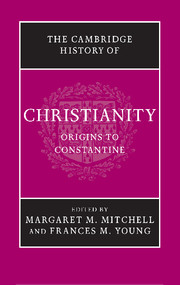Book contents
- Frontmatter
- Prelude: Jesus Christ, foundation of Christianity
- Part I The Political, Social and Religious Setting
- Part II The Jesus Movements
- Part III Community Traditions and Self-Definition
- Part IV Regional Varieties of Christianity in the First Three Centuries
- 15 From Jerusalem to the ends of the earth
- 16 Overview: the geographical spread of Christianity
- 17 Asia Minor and Achaea
- 18 Egypt
- 19 Syria and Mesopotamia
- 20 Gaul
- 21 North Africa
- 22 Rome
- Part V The Shaping of Christian Theology
- Part VI ‘Aliens’ become Citizens: towards Imperial Patronage
- Conclusion: retrospect and prospect
- Bibliographies
- Index
- Map 1. The Roman Empire in the time of Marcus Aurelius
- References
15 - From Jerusalem to the ends of the earth
from Part IV - Regional Varieties of Christianity in the First Three Centuries
Published online by Cambridge University Press: 28 March 2008
- Frontmatter
- Prelude: Jesus Christ, foundation of Christianity
- Part I The Political, Social and Religious Setting
- Part II The Jesus Movements
- Part III Community Traditions and Self-Definition
- Part IV Regional Varieties of Christianity in the First Three Centuries
- 15 From Jerusalem to the ends of the earth
- 16 Overview: the geographical spread of Christianity
- 17 Asia Minor and Achaea
- 18 Egypt
- 19 Syria and Mesopotamia
- 20 Gaul
- 21 North Africa
- 22 Rome
- Part V The Shaping of Christian Theology
- Part VI ‘Aliens’ become Citizens: towards Imperial Patronage
- Conclusion: retrospect and prospect
- Bibliographies
- Index
- Map 1. The Roman Empire in the time of Marcus Aurelius
- References
Summary
Both the apostle Paul and the risen Jesus (according to Luke) envision a spreading of the Christian movement out from Jerusalem into the circumference of the Mediterranean world, as far as Rome, and ‘to the ends of the earth’ (Acts 1:8; Rom 15:19, 24). The chapters in this section will trace the progress and effects of that dispersion of Christian communities in the first three centuries – to Asia Minor, Achaea, Egypt, Syria, Mesopotamia, Gaul, North Africa and Rome. The purpose of such regional explorations is to identify the local particularities of the Christian religion as it was established in each of these places in the first three centuries, while also noting similarities and fundamental coherences and correspondences between the regional churches as they emerged. The dominant features of each region – its historical-political history in relation to the Roman empire, its local religious cults and organisations, its languages and native customs – had an undeniable impact on how the Christian mission took root and grew on that soil. But this does not mean these churches had no sense of being part of a worldwide phenomenon, supported by regular communication and interconnections, and sharing some essential beliefs and practices.
In what may be the earliest extant Christian inscription (sometime before 216 ce), the famous epitaph of Abercius, bishop of Hieropolis in Phrygia Salutaris, recounts his own journeys at the end of the second century, self-consciously aligning himself with the earlier Pauline itinerary and experience – ‘everywhere’, he says, ‘we had Paul as our companion.’
Keywords
- Type
- Chapter
- Information
- The Cambridge History of Christianity , pp. 293 - 301Publisher: Cambridge University PressPrint publication year: 2006
References
- 1
- Cited by



